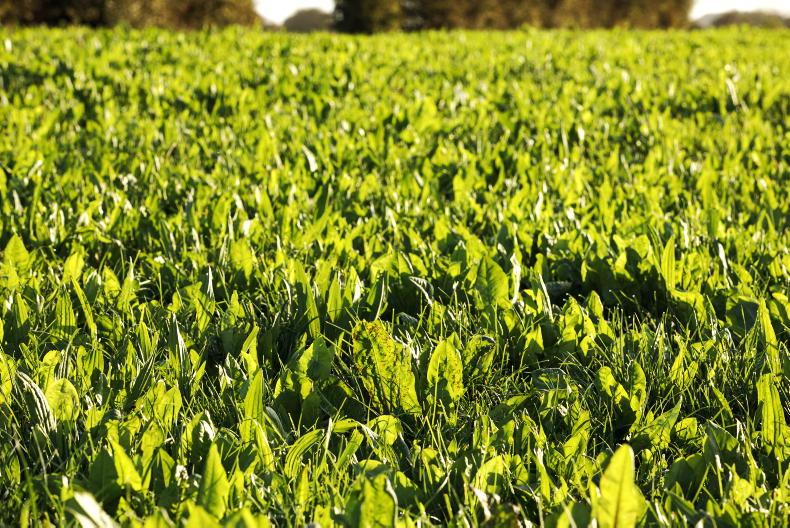Multispecies swards can deliver higher liveweight gains and economic and environmental benefits within livestock systems, Professor Tommy Boland from UCD explained during an Agriculture and Horticulture Development Board (AHDB) webinar last Thursday.
Boland outlined research results for cattle and sheep grazing on ryegrass only, ryegrass/white clover, and two multi-species swards (MSS).
The studies showed the daily liveweight gain of lambs on MSS was 18% higher (driven by ewe milking ability) than ryegrass-only swards from birth to six weeks of age.
“This trend continued through to weaning with lambs on the six species swards being 2.4kg heavier than lambs grazing on ryegrass-only swards at 14 weeks of age.
Post-weaning, lambs grazing on MSS, or a clover/ryegrass sward reached slaughter weight two weeks earlier than lambs grazed on ryegrass-only swards. Kill-out was also higher for lambs slaughtered off MSS,” said Boland.
Less N
In terms of overall herbage yields, MSS grew similar volumes to the perennial ryegrass swards but with 45% less nitrogen applied.
With anthelmintic resistance a growing problem on sheep farms, Boland also outlined how parasite burdens in lambs were affected by sward type.
All lambs were wormed at 10 weeks of age to control nematodirus. Lambs on ryegrass-only swards required a follow-up dose every 35 days, increasing to a 42 day interval on ryegrass/clover swards.
On MSS, the worming interval was longer at 51 days for a six-species sward and 58 days on a nine-species sward.
“Over the lifetime of the animals in each system, lambs on MSS required 50% fewer drench administrations, which is a huge cost and labour saving, as well as reducing anthelmintic resistance,” said Boland.
Cattle
Boland also touched on the role of MSS for cattle systems. He said that ongoing research has showed that ryegrass/white clover swards and MSS support higher daily liveweight gains in beef steers over ryegrass-only swards.
During the 2021 grazing season from April to late July, cattle on MSS have averaged 300g/day more than steers on ryegrass.
Over the 12 months since the study started, the steers that have been grazed on MSS are 80kg heavier than those on ryegrass-only swards.
Mixed grazing
Boland also referred to work being done in partnership with Devenish Nutrition on the Devenish research farm in Co Meath, which involves mixed grazing of beef and sheep on four sward types.
“Lambs on the MSS had 24% higher average daily weight gain from birth to slaughter compared to animals on perennial ryegrass or old permanent pasture,” said Boland.
Lambs on MSS were finished four weeks earlier.
Beef heifers on the six-species swards had 13% higher daily liveweight gain over grass-only swards.
The MSS have received about 35% of the fertiliser applied to ryegrass swards, yet herbage yields are significantly higher, concluded Boland.
Read more
Making a plan for a multispecies sward on Tullamore Farm
Farmer Writes: grassland theory versus practical reality
Multispecies swards can deliver higher liveweight gains and economic and environmental benefits within livestock systems, Professor Tommy Boland from UCD explained during an Agriculture and Horticulture Development Board (AHDB) webinar last Thursday.
Boland outlined research results for cattle and sheep grazing on ryegrass only, ryegrass/white clover, and two multi-species swards (MSS).
The studies showed the daily liveweight gain of lambs on MSS was 18% higher (driven by ewe milking ability) than ryegrass-only swards from birth to six weeks of age.
“This trend continued through to weaning with lambs on the six species swards being 2.4kg heavier than lambs grazing on ryegrass-only swards at 14 weeks of age.
Post-weaning, lambs grazing on MSS, or a clover/ryegrass sward reached slaughter weight two weeks earlier than lambs grazed on ryegrass-only swards. Kill-out was also higher for lambs slaughtered off MSS,” said Boland.
Less N
In terms of overall herbage yields, MSS grew similar volumes to the perennial ryegrass swards but with 45% less nitrogen applied.
With anthelmintic resistance a growing problem on sheep farms, Boland also outlined how parasite burdens in lambs were affected by sward type.
All lambs were wormed at 10 weeks of age to control nematodirus. Lambs on ryegrass-only swards required a follow-up dose every 35 days, increasing to a 42 day interval on ryegrass/clover swards.
On MSS, the worming interval was longer at 51 days for a six-species sward and 58 days on a nine-species sward.
“Over the lifetime of the animals in each system, lambs on MSS required 50% fewer drench administrations, which is a huge cost and labour saving, as well as reducing anthelmintic resistance,” said Boland.
Cattle
Boland also touched on the role of MSS for cattle systems. He said that ongoing research has showed that ryegrass/white clover swards and MSS support higher daily liveweight gains in beef steers over ryegrass-only swards.
During the 2021 grazing season from April to late July, cattle on MSS have averaged 300g/day more than steers on ryegrass.
Over the 12 months since the study started, the steers that have been grazed on MSS are 80kg heavier than those on ryegrass-only swards.
Mixed grazing
Boland also referred to work being done in partnership with Devenish Nutrition on the Devenish research farm in Co Meath, which involves mixed grazing of beef and sheep on four sward types.
“Lambs on the MSS had 24% higher average daily weight gain from birth to slaughter compared to animals on perennial ryegrass or old permanent pasture,” said Boland.
Lambs on MSS were finished four weeks earlier.
Beef heifers on the six-species swards had 13% higher daily liveweight gain over grass-only swards.
The MSS have received about 35% of the fertiliser applied to ryegrass swards, yet herbage yields are significantly higher, concluded Boland.
Read more
Making a plan for a multispecies sward on Tullamore Farm
Farmer Writes: grassland theory versus practical reality






 This is a subscriber-only article
This is a subscriber-only article










SHARING OPTIONS: